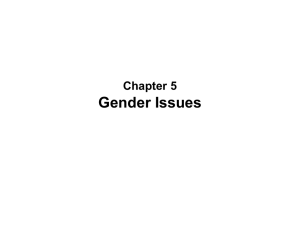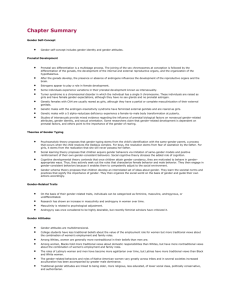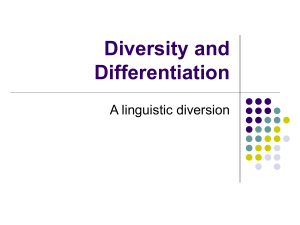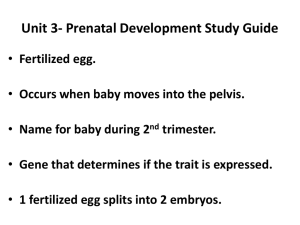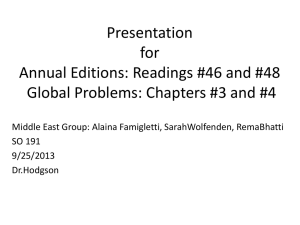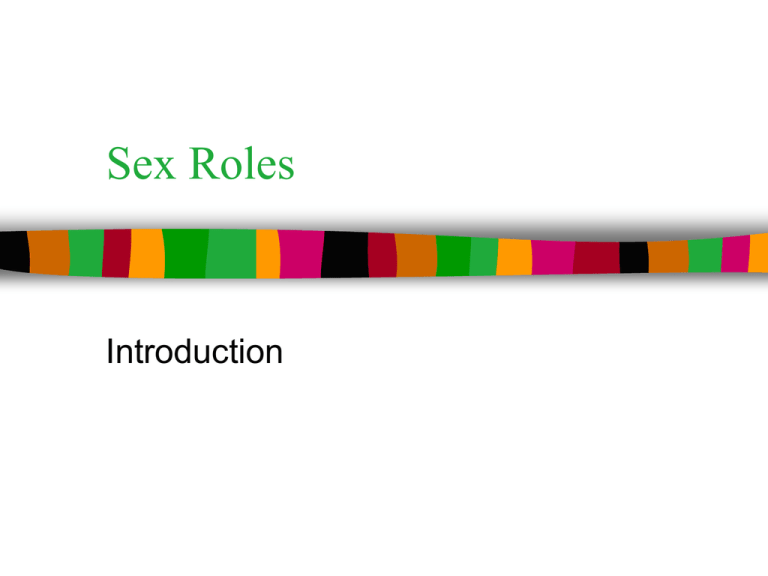
Sex Roles
Introduction
Sex Roles
Sex is biological
Gender is self or social conception of
masculinity and femininity
Virtually every known society
differentiates people on the basis of
gender
Also based on male domination
Gender-Identity Formation
Typical prenatal differentiation (6 weeks)
– 23 human chromosomes
• 22 autosomes and 1 sex chromosome
– Chromosomal sex
• XX: female
• DSS gene on X
• Ovaries
XY: male
SRY gene on Y
Testes
Typical Prenatal Differentiation
Part 1
Gonadal sex
– Ovaries or testes (DSS or SRY)
Hormonal sex
– Estrogens & androgens (once developed
release)
Sex Differentiation
Hypothalamus
• absent testosterone during prenatal
differentiation (pregnancy)
• leads to receptor cells initiating menstrual cycle
– Cerebral hemispheres
– Corpus callosum (thicker in women)
Typical Prenatal Differentiation
Part 2
Internal structures
– Mullerian (female) or Wolffian duct systems
develop into female or male internal organs
External structures
– Genital tubercle develops into clitoris or penis
– Labio-scrotal swelling develops into labia or
scrotum
Prenatal Differentiation of Internal Structures
Prenatal Differentiation of External Genitals
Prenatal Differentiation of External Genitals
Atypical Prenatal Differentiation
Part 1
Intersexed
– Hermaphrodites
• Both ovarian and testicular tissue
– Pseudohermaphrodites
• Gonads match chromosomal sex
Sex chromosome disorders (see table page 54)
– Turner’s syndrome XO
• Only 1 sex chromosome, external OK, internal not
developed
– Klinefelter’s syndrome
XXY
• Antomically male, sterile, little interest
Transsexualism and Transgenderism
Transexualism
– Cross gender identification and gender dysphoria
Transgendered
– People whose appearance and/or behavior does not
conform to traditional gender roles
Intersexed people
Gender Identity vs. sexual orientation
Options for Transsexuals
Gender blending / cross-dressing
Psychotherapy
Sex reassignment
Doing Gender
Should not be based on size
– Penis is too small, can’t possibly be a man
Gender is active
– Performance with props, signs, symbols,
behaviors, emotions
– Sex changes vs. cross dressers as
evidence
The Interactional Model
Acknowledgment of both nature and nurture
Relative roles are still unclear
Other Issues
Our culture believes certain characteristics
are feminine and thus should not be part of
being male
–
–
–
–
Males: independent and aggressive
Females: nonassertive, warm, and nurturant
Recent trend away from rigid stereotypes
Ethnic Variation in gender roles
What happens when women or men decide
to contradict the larger culture’s views on
femininity or masculinity?
Margaret Mead
Found that in some societies men are
more emotional and feminine than the
women in that society
Argued that personality differences
between the sexes are cultural
creations, which we are trained to
conform
Margaret Mead
Majority of society will conform, few
deviants
However she wanted to know why men
and women were so divided in most
cultures- regardless of the division
Why are boys taught not to show fear
and for girls it is okay to show fear?
Institutions
5 Social Institutions
– Family, economy, religion, political order,
and education
– Let’s focus on family and school for now
Family
First thing known about new baby
Toys
Chores
Role models
School
Boys and girls reinforce and teach
gender
Males receive more attention in class
– They need it, can’t sit still, etc.
– Demand more of it, call out
Changes
Despite this extra attention boys
generally do worse in school
ADD, mentally retarded, learning
disabled (71%), emotionally disturbed
(81%)
Schools are run by women, for girls
– Expected to sit quietly
Effects
Boys tend to be overconfident
Girls begin to undervalue their abilities
Comparing math scores when girls and
boys did the same, boys rate their
abilities higher and girls lower
The best thing about being a
boy…
Playing Sports (24.5%)
Being Strong (20.7%)
Entitlement (17.7%)
– Listened to more
– Allowed to do more
– Greater respect
The best thing about being a
girl…
Appearance (22.5%)
Nothing (17.7%)
– More boys than girls submitted this answer
Academic Advantage (13.4%)
Androgyny: Transcending Gender Roles
Blending of typical male and female behaviors in one
individual
Benefits and drawbacks
May show more flexibility & comfort with sexuality

